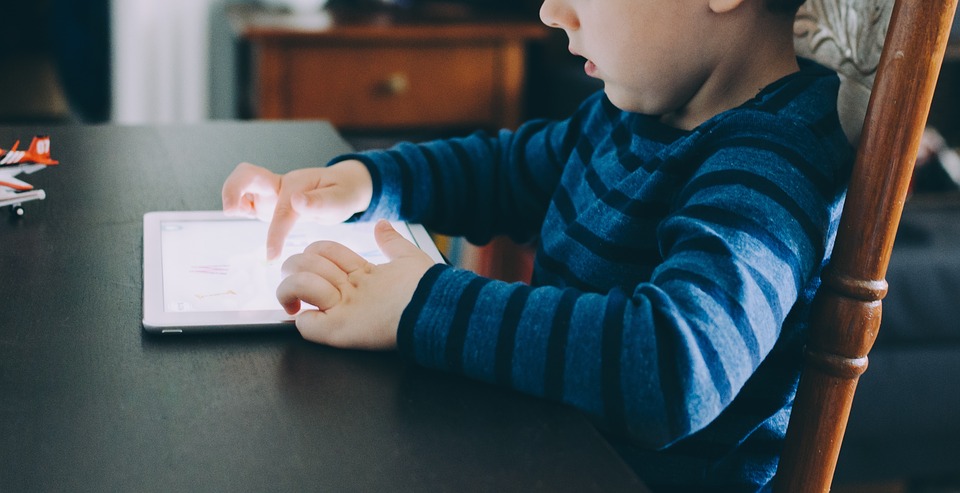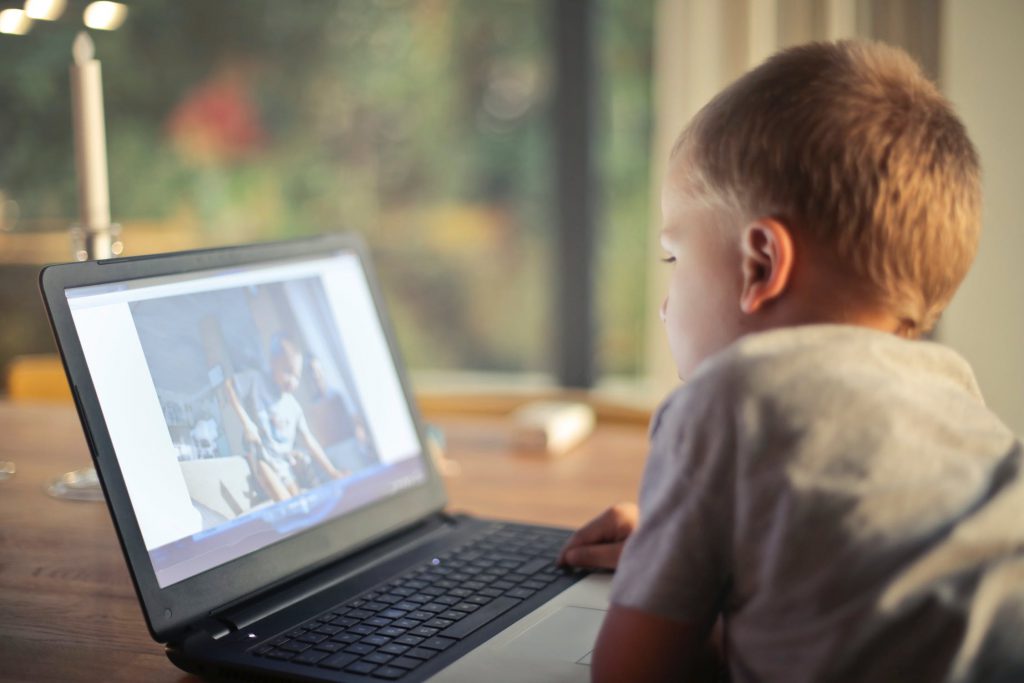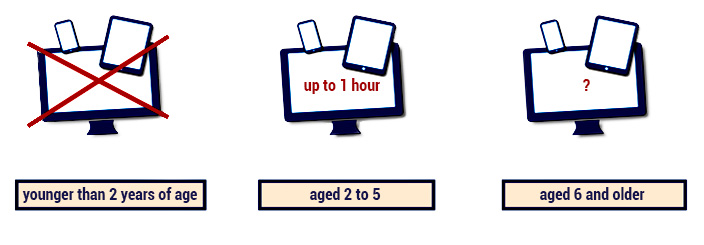Screen time – how much and how?
Screen time – how much and how?
Author: Dobrinka Kuzmanović, PhD

Today’s children spend much time in front of the screens of smartphones, tablets, computers, TVs. From the very beginning of their life, they are surrounded by digital devices, and as confirmed by research findings, in addition to spending more and more time in front of the screen, they begin to use them at an increasingly younger age.
The digital age has presented parents, educators and the scientific community with numerous issues related to the proper use of digital technology in childhood. The most important among them are:
- How much time a day can a child use digital devices without negative effects on his/her psycho-physical development, health and general well-being?
- What is quality screen time?

If you have already been looking for answers to these or similar questions (e.g. on Google), you have probably come across some contradictory, frustrated or overly negative views on the impact of digital technology on children’s behaviour and development. You might have concluded that ‘screen time’ is one of the greatest concerns of ours, and that technology is ‘the main culprit’ for the lack of appropriate social skills in children, slow development of speech and brain, lack of interest in reading classic books and playing traditional games with peers, obesity, depression, etc.
Nevertheless, we should bear in mind that so-called ‘moral panic’ in connection with the negative aspects of using digital technology is not new, or solely related to this technology. A similar ‘panic’ was present in the 1960s, after the appearance of television.
While experts write protest letters to governments and the media because they believe that screen time is increasingly “deteriorating children’s health” and “poisoning their childhood,” scientists claim that there is no reliable scientific evidence supporting the claim that digital display screens are harmful (e.g. Sonia Livingstone, a renowned professor of social psychology at the London School of Economics, one of the initiators of the blog Parenting for a Digital Future, which contains a lot of useful content on this subject).
Digital technology is evolving at such a rate that scientific research cannot keep up with ever-faster technological development. Most research refers to the time spent in front of the television screen, so the existing findings on the impact of technology on child development need to be re-examined in the context of new, interactive media.
So, if you expect to get a ‘recipe’ in this text, or a simple answer based on reliable empirical findings, you will be disappointed by the fact that today’s science has no answer to the questions posed in the title of the text. Instead, we offer you guidelines that you will be able to adapt to your family context and the individual characteristics of your children.

How much screen time is too much for a child?
- How much time a day a child can spend in front of the screen, without harming his/her development, depends on several factors:
- the age of the child
- types of activity on digital devices (e.g. playing video games, watching videos that are not appropriate to the child’s age, or learning a foreign language or how to play the guitar)
- the ways of using (e.g. whether the child does something on his own, or uses a digital device in the presence of an adult being involved in such activities)
- psycho-physical condition (whether the child is physically active, relaxed and cheerful or unsettled, absentminded, disturbed, complaining about problems such as headache, tired eyes …)
- the child’s interest (whether the activity on a digital device is the child’s choice, tailored to his/her abilities, personality characteristics)
- the context in which digital devices are used (e.g. whether they are used during meals, before bedtime, whether the child has correct body position while sitting in front of the screen)
- the type of digital device, i.e. the possibilities it provides children with (e.g. sitting in front of a TV screen puts the child in a passive, ‘consumer’ position, while interactive digital devices, such as a tablet or a computer or game console, provide the ability to be mentally and physically active, to create content and exchange it with peers, etc.)
Even if the experts agreed with each other in relation to the optimal time in front of the screen, some dilemmas would remain:
- Can a parent or other person taking care of a child have complete control over the amount of time a child spends in front of the screen during a day, given that digital devices have interfered with almost all aspects of everyday life?
- What does ‘screen time’ mean? Is it time exclusively reserved for entertainment, gaming, communication, or also time for learning with the help of digital technology (at home and/or at a preschool institution/school)?
- Does the screen time include the time when the child is physically active in front of the screen? (games that provide children with so-called ‘augmented reality’ are becoming more and more popular).
Screen time – what experts say

The American Academy of Pediatrics (AAP) published the first guidelines on children’s screen use back in 1999, when digital technology was significantly less accessible to children than today. According to these guidelines, children under the age of 2 should not spend time in front of the screen at all, while children older than 2 should not be exposed to the screen for more than two hours a day.
After nearly two decades since the first guidelines, the AAP published revised recommendations in 2016, adapted to the demands of modern lifestyles and the increasing use of digital devices.
According to the new recommendations:
- Children under 18 months of age should not spend time in front of the screen (TVs, mobile phones, tablets, computers) at all. At this age, it is acceptable for children to participate in conversations of adults via video chat, assuming that the adults have adjusted the way of communication to the child. If parents of children between the ages of 1.5 and 2 want to introduce digital media, they have to choose high-quality content and help children understand it.
- Children aged 2 to 5 should not use digital devices for more than one hour a day, and such time should be well planned and organized (which implies educational and age-appropriate content and activities), with active involvement of adults.
- For children aged 6 and over, adults need to design an individual plan for using digital devices and the Internet, ensuring that the time spent in front of the screen does not replace social, cognitive and physical activities important for the child’s development (sleep, outdoor play, sports, communication with family members and friends).

Note that in Europe there are no concrete guidelines on optimal use of digital devices by children.
Indicators of excessive use of digital devices by children
Childhood is a sensitive period in the development of a person for it is accompanied by numerous changes in various aspects of functioning: social, biological, physical, intellectual, emotional. For normal psycho-physical development of children of all ages, daily physical activity (at least 60 minutes a day) and a good sleep (between 8 and 12 hours a day, depending on age) are necessary.
Physical activity helps children explore and get to know the world around them, experiment, learn and gain new experiences. Motor and cognitive (intellectual) development are closely linked. For optimal psycho-physical development it is necessary to provide conditions for practical research, enabling children to adopt numerous and various sensory and motor experiences in direct contact with physical objects and people close to them.
When it comes to excessive use of screen time, it is usually connected with so-called sedentary behaviour (behaviour that requires no physical activity or physical energy consumption).
Sedentary behaviour can be classified into two groups:
- Productive: reading, listening to stories, or viewing picture books; the so-called silent play: drawing, doing pattern puzzles, creative activities (e.g. games with plasticine, cubes, making items from different materials); sleep, and
- Unproductive: watching TV for the purpose of entertainment; playing video games (not all of them; it depends on the type of game, e.g. playing educational games is considered a productive activity); sitting in a fixed position for a long time (in a car, on a high chair, in a children’s carriage).

Lack of sleep is often associated with excessive use of digital devices, as well as their use before bedtime. The screens of digital devices affect our sleep by reducing the level of melatonin, stimulating our brain and interrupting sleep periodically. The blue light emitted by screens of digital devices reduces the production of melatonin, a hormone that helps us fall asleep, and thus unnaturally disturbs the sleep cycle. Visual and sound content (especially those that encourage thoughts or provoke negative emotions, excite or irritate the child) stimulate the brain and keep it awake. All electronic devices emit light that can disturb the sleep, even when the device is turned off (for example, a light on the on/off button of the monitor). Sound warnings and notifications also negatively affect the quality of sleep. Click here and learn how technology affects our sleep and why digital devices are not recommended in the bedroom, i.e. at bedtime.
Is there any reason to be worried?
If you agree with most of the indicators listed below, it is possible that your child spends too much time using digital devices/the Internet:
- The child often complains of headache, neck or back pain, blurred vision
- The child has difficulty to fall asleep, does not sleep enough, is tired or sleepy
- It happens that he/she forgets to eat or skips meals, being busy with the activities in front of the screen
- The child is obsessed with activities on the Internet, this is the only thing he/she is concerned about, cannot wait to take the device
- The child has problems with attention, is unable to focus on one thing
- The child appears unusually emotional or irritated
- The child mainly communicates over the Internet and ignores social contacts with family and peers outside the Internet
- The child has been less successful in school activities since he/she started activities on digital devices/the Internet
- The child ignores interests and hobbies outside the Internet, sports activities
- The child uses the Internet solely for entertainment, never for learning, finding information, creating content, etc.
- The digital device is often overheated or switches off automatically after being used for a long time.
What is quality screen time?
According to expert opinion, the quality of the time a child spends using digital devices is more important than the amount of time. What matters is the activity the child is involved with, whether the child is mentally active, what kind of content he/she uses (for children or adults), whether the child uses applications designed to meet his/her abilities and needs and whether parents/adults provide appropriate help and support.
Quality screen time means that:
- The child uses digital devices together with parents/adults who direct the activities, help the child understand what he/she is doing and connect and apply it in everyday life, motivate him/her to persevere in challenging activities, give feedback on the correctness of the child’s activities
- Activities on digital devices are appropriate for the age of the child, i.e. his/her intellectual and emotional needs, stimulating the child’s development
- Adults observe the child’s activity on digital devices, as well as the purpose of it: can he/she learn something out of it, develop creativity, imagination, thinking skills, etc.
- Applications are technically well-designed, without too much information that shifts quickly, adapted to the child’s ability to receive information
- The child has access to specific educational content
- When using digital devices/the Internet, the child has no access to commercial content (ads) and links leading to inappropriate content
- When using digital devices/the Internet, the child has no access to content promoting aggression, violence, any form of prejudice or discrimination.
How can adults manage the child’s screen time?
The role of parents/adults is essential for development of healthy habits when it comes to children using digital technology. Regardless of the changed context in which today’s children, the so-called digital natives, grow up, the parental role has not changed.

Parents are expected to manage the child’s time in front of the screen, i.e. to apply the same rules in the digital environment: they should participate in their children’s activities, set boundaries, know what children do and what they use digital devices for, and act as good models of behaviour for their children.
If you have preschool or lower-primary school children in your family, ask yourself the following questions:
- What digital devices do you have in your home, which of them does your child use?
- Are adults actively involved with the child’s use of digital devices?
- What are you watching/doing with a child on a digital device? What does a child watch/do in your absence?
- Has your child learned or created something with your help on a digital device?
- Do you view adult content in the presence of the child or together with him/her? How often do you do that?
- Do you watch a cartoon or any content on the Internet before making it available to the child? Do you pay attention to age restrictions that are clearly indicated on video games?
- Do you know where you can find information about Internet content relevant to the age and developmental needs of your child?
- How often do you initiate a conversation with your child about his/her activity on digital devices? Do you talk to your child about his/her likes and dislikes, fears…?
- Do you know what parental controls are? Have you ever applied technical child protection measures during the use of digital devices and the Internet?
- Do you comment on or explain to your child the activity that can be performed or the content that can be viewed on a digital device?
- Is your child allowed to use digital devices (phone, computer, smart TV) in the bedroom? Does the child use them before bedtime?
- Does anyone in the family use digital devices during a meal?
- How often do you give your child a digital device just to have fun while you are doing the housework?
- How often is the TV turned on (in the background) although you are not watching it, but occupied with some other activity?
- Has your family defined rules on the use of digital devices and do the adults abide by them?
In order to ensure the right balance between time spent online and offline, you should:
- Have places at home without the Internet, as well as periods during a day without digital devices
- Use technology in a creative and meaningful way (e.g. for learning, exploring, creating content in digital format)
- Keep in mind that screen time can in no way replace the time for sleep, physical activity, playing outside and communication with close people




